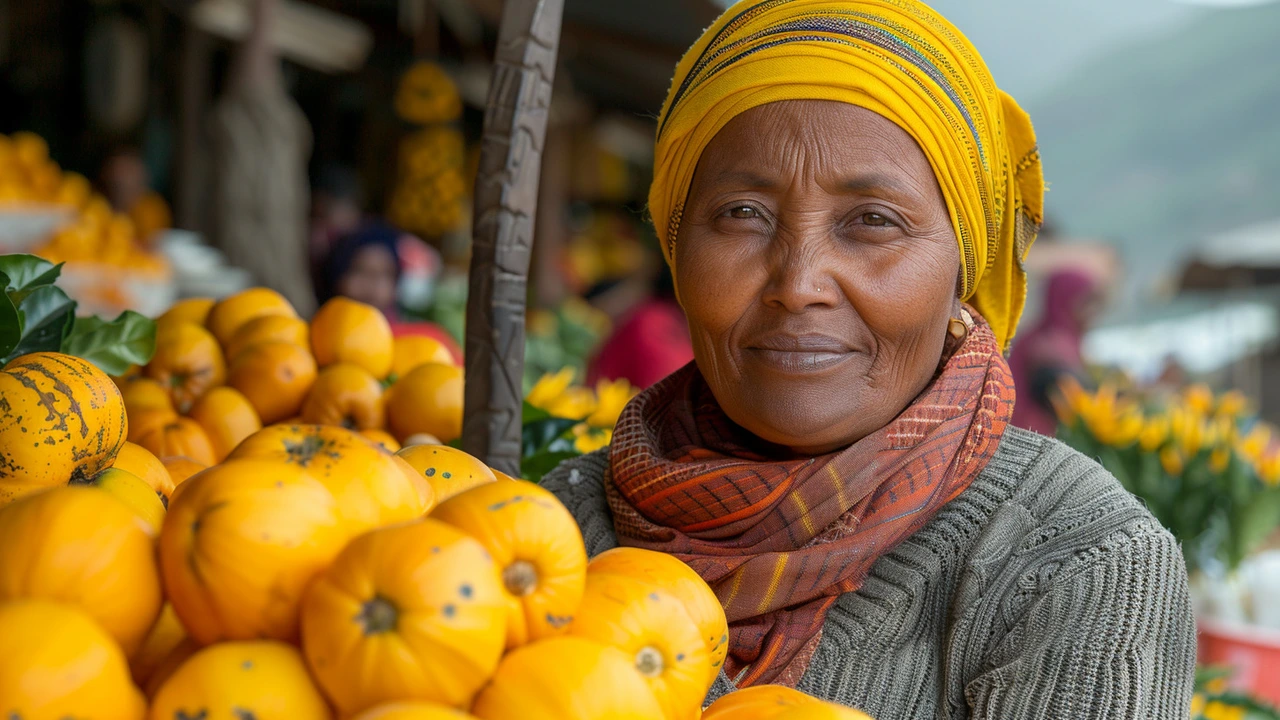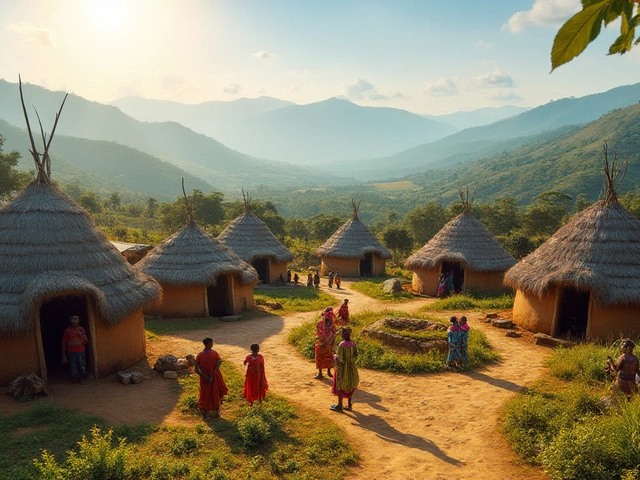Ethiopia, positioned proudly in the Horn of Africa, often stands in stark contrast to other African nations. Its unique history and traditions have cultivated an identity that is distinctly Ethiopian.
History buffs find Ethiopia captivating due to its ancient roots and historical significance. From the early days of the Kingdom of Aksum to the fascinating narrative of Emperor Haile Selassie, the country's past is both intricate and vital. Each epoch has contributed to its rich tapestry, setting it apart from the rest of the continent.
- Historical Significance
- Geographical Diversity
- Cultural Richness
- Language and Script
- Religious Landscape
- Uncolonized Heritage
Historical Significance
Ethiopia's history is not just a sequence of events; it is the heartbeat of a nation that has shaped the African continent in profound ways. One of the most significant aspects of Ethiopia’s history is its ancient civilization, the Kingdom of Aksum. Dating back to the first millennium BC, Aksum was a thriving empire known for its impressive architecture and advanced technologies. The iconic obelisks of Aksum, some standing over 20 meters tall, tell tales of a kingdom that was a center of trade and culture.
Aksum’s historical narrative is incomplete without mentioning the treasures of the lost Ark of the Covenant, rumored to be housed in the Church of Saint Mary of Zion. This connection to biblical history adds another layer to Ethiopia's rich historical tapestry. The claims have sparked curiosity and pilgrimage, making Ethiopia a critical point on the religious and historical map.
Moving to the medieval era, Ethiopia continued to hold its ground. The reign of Emperor Zara Yaqob in the 15th century was marked by significant ecclesiastical and secular advancements. His rule established a strong Christian rule that saw the construction of many churches, some of which stand to this day as marvels of medieval architecture.
Fast forward to modern history, the story of Ethiopia's resistance against colonization sets it apart significantly. Unlike most African countries, Ethiopia managed to avoid European colonization, with the notable exception of the brief Italian occupation from 1936 to 1941. The Battle of Adwa in 1896 was a turning point, where Ethiopian forces, under Emperor Menelik II, defeated the Italian army. This victory brought Ethiopia international acclaim and cemented its status as an icon of African sovereignty.
Emperor Haile Selassie, often referred to as the father of modern Africa, played a significant role in the country’s 20th-century history. He was instrumental in founding the Organization of African Unity, which later became the African Union, headquartered in Addis Ababa. His vision for a united Africa has left an indelible mark on the continent's political landscape.
Moreover, Ethiopia's historical significance is enshrined in its role as the birthplace of coffee. Coffee, which plays a central role in Ethiopian culture and religious ceremonies, was first discovered in the region of Kaffa. This simple yet profound discovery has influenced global cultures and economies, exporting Ethiopian heritage worldwide.
"Ethiopia is a symbol of African independence and pride. The Battle of Adwa and the enduring legacy of Haile Selassie are testimonies to the country's resilience and courage." - Historian Richard Pankhurst
Ethiopia's woven tapestry of history is dense and intricate, ranging from the ancient solomonid dynasty to its pivotal moments in modern African history. It is these historical facets that forge Ethiopia's unique identity, making it a nation unlike any other on the continent.
Geographical Diversity
Ethiopia's geographical diversity is nothing short of astonishing. This country offers a mixture of landscapes that could easily belong to different worlds. From towering mountains to sprawling deserts, deep rift valleys to vast lakes, Ethiopia showcases a variety like no other place in Africa.
One of the most striking features is the Ethiopian Highlands, often dubbed the 'Roof of Africa'. These highlands are home to Ras Dashen, which is the highest peak in Ethiopia, standing at a majestic 4,550 meters. The scenic Simien Mountains, part of the highlands and a UNESCO World Heritage site, are known for their dramatic vistas, distinctive erosion formations, and rich wildlife. Visiting these highlands feels like stepping into a past era, where the rugged, distinctive landscape tells stories of ancient geological processes.
A dramatic counterpoint to the highlands is the Danakil Depression in the northeastern part of the country. Often cited as one of the hottest places on Earth, this unique geological wonder lies more than 100 meters below sea level. The area is renowned for its extreme heat and hostile environment, but also for its otherworldly beauty – vibrant salt flats, active volcanoes, and colorful sulfur springs create a landscape that feels almost Martian. Despite its name, the depression is teeming with life, including the Afar people who have adapted to this harsh environment over centuries.
Water bodies such as Lake Tana, the largest lake in Ethiopia and the source of the Blue Nile, add another layer of diversity. Lake Tana not only supports a diverse ecosystem but is also culturally significant due to its island monasteries that date back to the early Christian era. Equally impressive are the Great Rift Valley lakes which serve as key migratory bird habitats, attracting bird watchers from around the globe. The Rift Valley itself cuts through Ethiopia, creating dramatic escarpments and fertile plains.
The Omo Valley offers yet another fascinating geographic tapestry. Situated in the southwest, this area is known for its relatively untouched landscapes and indigenous tribes. The Omo River snakes through arid plains and lush valleys, fostering an environment where traditional ways of life have been preserved for millennia. This region is a hotbed for anthropologists and tourists alike, keen to understand how human societies have adapted to diverse ecological niches.
Not to be overlooked are Ethiopia’s deserts, particularly the Ogaden Desert in the southeast. This arid region is known for its challenging living conditions but has been a critical area for nomadic tribes who navigate its sparse landscape with remarkable expertise. These deserts are not just barren lands; they are rich in natural gas reserves and have a subtle, rugged beauty that enthralls adventurous travelers.
So whether it is the high peaks of the Simien Mountains, the fiery pits of the Danakil Depression, the serene expanse of Lake Tana, or the intricate ecosystems of the Rift Valley, Ethiopia’s geographical variety is unmatched. Its landscapes are not just backdrops but integral characters that have shaped the nation's culture, history, and way of life.

Cultural Richness
Ethiopia's cultural landscape is a breathtaking mosaic stitched from various traditions, languages, and lifestyles. Home to over 80 ethnic groups, each with its language and customs, the nation's cultural diversity is one of its greatest treasures. The largest ethnic group is the Oromo, followed by the Amhara, the Somali, and the Tigray. Each of these groups brings its rich heritage to the mosaic, creating a vibrant and dynamic cultural tapestry.
The annual Timkat festival, celebrated by Ethiopian Orthodox Christians, is a stunning display of tradition and devotion. Marking the Epiphany, this festival transforms the streets with colorful processions, people adorned in white clothing, and joyous rituals that date back centuries. The celebration reenacts the baptism of Jesus Christ in the Jordan River, and the faithful gather at rivers or pools to participate in symbolic immersions.
"Ethiopia is not just a country but a living museum of diverse cultures." - Richard Pankhurst, historian.
Music and dance also play a significant role in Ethiopian cultural expression. Traditional music often uses unique scales and rhythms not found anywhere else in Africa or the world. Instruments like the krar (a lyre) and the masenqo (a single-stringed fiddle) create distinctive sounds that are both haunting and beautiful. The eskista, a traditional dance characterized by rhythmic shoulder movements, is an energetic and infectious display of cultural celebration.
In culinary terms, Ethiopia is renowned for its rich and aromatic dishes, with injera—a sour, spongy flatbread—taking center stage. Meals often become communal experiences, where people gather around shared plates to enjoy dishes like doro wat (spicy chicken stew) and kitfo (minced raw beef). The use of various spices, like berbere and mitmita, adds depth and complexity to the flavors, making Ethiopian cuisine a hit worldwide.
Coffee, believed to have originated in Ethiopia, is more than just a beverage here; it's a cultural institution. The traditional Ethiopian coffee ceremony is a social event that involves roasting beans, grinding them, and brewing the coffee in a jebena (clay pot). This elaborate ritual is a time for family and friends to come together, chat, and bond over multiple rounds of strong, aromatic coffee.
Craftsmanship and artistry are other pillars of Ethiopian culture. From the intricate patterns of traditional handwoven textiles to the exquisite designs in copper and silver jewelry, Ethiopian artisans showcase their skills through their meticulous work. Ethiopian crosses, often made of silver and elaborately designed, are not just religious symbols but also art pieces treasured by collectors.
The country's literary tradition is also rich, with ancient texts like the Kebra Nagast (The Glory of Kings) offering insights into Ethiopia's royal lineage and religious history. Modern Ethiopian writers continue to celebrate and critique their culture through poetry, novels, and essays, further enriching the nation's literary heritage.
Language and Script
One of Ethiopia's most fascinating aspects is its linguistic and scriptural heritage. The primary language spoken by the population is Amharic, which uses a unique script known as Ge'ez or Fidel. This script has been in use since ancient times and is still functional today, setting Ethiopia apart from its African peers who mostly use Latin-based scripts. Learning Ge'ez is akin to peeling back layers of history, as it connects modern Ethiopians to their ancient ancestors.
But Amharic is just the tip of the iceberg. Ethiopia is a melting pot of languages, with over 80 distinct languages spoken across the country. The Oromo language, spoken by the Oromo people—who are the largest ethnic group in Ethiopia—uses the Latin script, while Tigrinya and Somali are also widely spoken and have their scripts and linguistic nuances. This linguistic diversity enriches the country's cultural fabric, offering a window into the varied ways of life and thought processes of its inhabitants.
The Ge'ez script is not only used for everyday communication but also holds religious significance. It is the liturgical language of the Ethiopian Orthodox Tewahedo Church, one of the oldest Christian churches in the world. Manuscripts written in Ge'ez date back to the 4th century and are written on goatskin parchments. Such ancient texts are well-preserved in monasteries, serving as a treasure trove for researchers and historians.
Ge’ez manuscripts are akin to living fossils, preserving Ethiopia's rich history for current and future generations, says Dr. Sergew Hable Sellassie, a renowned Ethiopian historian.
Another intriguing aspect is the phonetic richness of Ethiopian languages. For example, Amharic contains a variety of consonant and vowel sounds that don’t exist in English or many other languages, making it both a challenge and a joy to learn. The language's poetic undertones lend themselves well to literature and songs, especially in 'qene,' a form of Amharic poetry known for its depth and ingenuity. Learning Amharic or any Ethiopian language provides a unique perspective into this nation's storied past and vibrant present.
For travelers and expatriates, picking up basic phrases in Amharic is often an eye-opener to Ethiopian hospitality. Whether you’re in bustling markets of Addis Ababa or the serene highlands of Lalibela, a simple “Selam” (hello) or “Ameseginalehu” (thank you) can go a long way in making lasting connections with the locals. Many Ethiopians appreciate the effort and are more than willing to help you with more complex phrases and nuances. Immersing oneself in the language enriches the travel experience, broadening the understanding of the Ethiopian way of life. Using language as a bridge can transform an ordinary visit into a memorable cultural exchange.

Religious Landscape
Religion permeates every aspect of Ethiopian life, showcasing a profound spiritual heritage that distinguishes the country from its African counterparts. Christianity took root in Ethiopia long before many other parts of the world. The Ethiopian Orthodox Church, one of the earliest Christian bodies, is central to this narrative. Its foundations date back to the 4th century AD, when King Ezana of the Aksumite Empire adopted Christianity. Today, the faith remains a beacon, with millions adhering to its ancient customs, rituals, and teachings.
Islam also has a venerable history in Ethiopia. The city of Harar, known as the “City of Saints,” boasts over 80 mosques. Harar is recognized for its significance in Islamic culture, being one of the oldest, continuously inhabited Muslim towns in the world. This town embodies centuries of peaceful coexistence and mutual respect between Christians and Muslims, a testament to Ethiopia's inclusive spiritual ethos.
“Ethnic and religious diversity has been the cornerstone of Ethiopia's identity. It's this intricate mosaic of beliefs that makes the nation extraordinarily unique.” - Dr. Richard Pankhurst
Jews, too, have deep-rooted connections to Ethiopia. The Beta Israel community, often referred to as Ethiopian Jews, claim descent from King Solomon and the Queen of Sheba. Their history is a fascinating chapter in Ethiopia's spiritual heritage, blending African traditions with Hebraic practices. For centuries, Beta Israel maintained their unique identity in the remote areas of Gonder and Tigray until many were relocated to Israel during Operation Moses and Operation Solomon in the late 20th century.
The presence of various faiths has fostered a tradition of religious festivals that draw visitors from around the globe. Timkat, the Ethiopian Orthodox celebration of Epiphany, vividly illustrates this. Celebrated with fervor, the festival involves processions, prayers, and traditional music, culminating in a symbolic reenactment of Christ's baptism in the Jordan River. Similarly, the Islamic festival of Eid al-Fitr is observed with equal devotion, marked by prayers, feasts, and communal gatherings. These events demonstrate Ethiopia’s vibrant religious tapestry. The distinctive Ethiopian calendar, which includes 13 months and is about seven years behind the Gregorian calendar, also highlights the country’s unique spiritual perspectives.
Uncolonized Heritage
One of Ethiopia's most distinguishing features is its status as Africa's oldest uncolonized country. While many African nations underwent prolonged periods of colonial rule during the 'Scramble for Africa,' Ethiopia remained fiercely independent, barring a brief Italian occupation from 1936 to 1941.
This resistance to colonization is deeply ingrained in Ethiopian national identity. The Battle of Adwa in 1896 stands as a significant historical event where Ethiopian forces, led by Emperor Menelik II, decisively defeated the Italian army. This victory did not only preserve Ethiopia's sovereignty but also resonated deeply within the wider African context, symbolizing hope and resistance against colonial subjugation.
Menelik II's strategic vision and adeptness at leveraging international diplomacy played critical roles in maintaining Ethiopia’s independence. He modernized the military by acquiring advanced weaponry and built alliances with European powers, deftly playing one against the other. This diplomatic acumen was fundamental in dissuading colonial ambitions. An interesting fact to note is that Ethiopia, unlike its contemporaries, operated comprehensive and structured diplomacy, something many modern historians credit to its uncolonized status.
"Ethiopia is a sovereign power. We have been independent for over 2,000 years, and it is our heritage and pride," wrote the acclaimed Ethiopian scholar, Richard Pankhurst.The brief Italian occupation during Mussolini's fascist regime was a turbulent chapter, but one from which Ethiopia emerged resilient. Emperor Haile Selassie’s passionate plea for help at the League of Nations is a testament to Ethiopia's unyielding spirit. Upon his return to power, Haile Selassie initiated various modernization reforms, preserving Ethiopia's sovereignty while embarking on a journey towards modernization and development.
The lack of colonial rule has also profoundly impacted Ethiopia's socio-cultural fabric. Traditional practices, languages, and religious institutions have been preserved with little external influence. This autonomy is visible today in the form of Ethiopia’s unique script, the Ge'ez script, and distinctive Christian practices under the Ethiopian Orthodox Tewahedo Church. Ethiopia also maintains its timekeeping system and calendar, further emphasizing its distinct heritage.
A visit to Ethiopia provides a rare glimpse into Africa's unfiltered cultural and historical continuity. The castles of Gondar, the obelisks of Axum, and the rock-hewn churches of Lalibela all stand as monumental testimonies to a civilization that has evolved independently for millennia. Each site shares a story that is uniquely Ethiopian, untouched by the homogenizing forces of colonial histories.
In today's globalized world, Ethiopia's uncolonized heritage serves as a powerful reminder of resilience, independence, and cultural pride. This historical sovereignty has cultivated a unique national identity that continues to inspire and inform its modern narrative, standing tall as an unyielding beacon of independence on the African continent.

 Why Ethiopia is Thriving: Unveiling the Secrets Behind Its Success
Why Ethiopia is Thriving: Unveiling the Secrets Behind Its Success
 Top High-Paying Jobs in Ethiopia in 2024
Top High-Paying Jobs in Ethiopia in 2024
 Best Trades to Explore in Ethiopia: Insights and Opportunities
Best Trades to Explore in Ethiopia: Insights and Opportunities
 Discover the Highest Paid Jobs in Ethiopia: An In-Depth Guide
Discover the Highest Paid Jobs in Ethiopia: An In-Depth Guide
 Living Conditions and Housing Types in Ethiopia
Living Conditions and Housing Types in Ethiopia
Ify Okocha
June 27, 2024 AT 17:43Your glorification of Ethiopia completely ignores its ongoing political turmoil.
William Anderson
June 27, 2024 AT 18:16The narrative of Ethiopia as a flawless cradle of civilization is bordering on mythic hyperbole. While the country indeed boasts an impressive historical record, the prose here glosses over the stark contradictions that pepper its modern reality. One cannot simply parade ancient obelisks while pretending that contemporary economic disparities have vanished. The author’s penchant for romanticizing the highlands and the Danakil Depression betrays a selective memory that would make a Victorian travelogue blush. Moreover, the punctuation in the original text teeters on the edge of chaos, a detail that any diligent editor would mercilessly rectify.
Sherri Gassaway
June 27, 2024 AT 19:06The very act of cataloguing Ethiopia’s myriad achievements invites a deeper reflection on what constitutes national identity. One might argue that the persistence of ancient traditions is not merely a relic but a living dialogue between past and present. In this dialogue, the stones of Aksum converse with the silicon of modern smartphones, producing a chorus of continuity that defies linear historiography. Yet the chorus is not without discord; the voices of marginalized groups often remain muffled beneath the clamor of grand narratives. The emphasis on a singular, uncolonized legacy conveniently eclipses the stories of those who suffered under feudal hierarchies. By foregrounding a triumphant battle at Adwa, the text risks reducing complex geopolitics to a convenient emblem of resistance. Such reduction, while emotionally satisfying, obscures the nuanced reality of Ethiopia’s entangled regional politics. Furthermore, the celebration of the Ge'ez script as an isolated cultural artifact neglects its syncretic influences from neighboring Semitic languages. The language policies that elevate Amharic above other tongues reveal a tension between unity and cultural hegemony. While the coffee ceremony is rightly highlighted as a cultural touchstone, its global commodification introduces paradoxes of exploitation and cultural appropriation. The author’s omission of these paradoxes signals an aversion to grappling with uncomfortable truths. In examining the highlands and the Danakil Depression, one must also confront the environmental strains imposed on local communities. The narrative’s lyrical tone, though captivating, occasionally slides into a veneer that masks systemic inequities. Ultimately, the act of admiration must be tempered with critical inquiry, lest reverence become an unexamined endorsement. The reader, therefore, is invited to navigate between admiration and scrutiny, recognizing that Ethiopia’s story, like any other, is a tapestry woven with threads of both brilliance and blemish.
Milo Cado
June 27, 2024 AT 20:13I truly appreciate how the piece captures Ethiopia’s diverse landscapes, from the soaring Simien peaks to the surreal Danakil flats. Your enthusiasm shines through, and it invites readers to explore these wonders with genuine curiosity 😊. The inclusion of cultural festivals adds a human dimension that is often missing in dry travelogues. Keep up the engaging storytelling, and perhaps consider adding personal anecdotes to deepen the connection. 🌍
MONA RAMIDI
June 27, 2024 AT 21:53The article tries to paint Ethiopia as an untouchable paradise, yet it conveniently sidesteps the harsh realities faced by countless citizens. This selective storytelling feels like an emotional manipulation designed to elicit admiration without accountability. By ignoring the socioeconomic struggles that persist, the narrative becomes a hollow propaganda piece. It’s time to demand a more balanced portrayal that acknowledges both triumphs and tribulations.
grace riehman
June 27, 2024 AT 23:50Hey folks, just wanted to say that sharing these facts about Ethiopia is really awsome cuz it helps people see how rich cultures can be. Even though the piece is long, it does a good job of making the history accesible. Let’s keep the convo going and maybe add some personal stories from people who have visited or lived there. It’ll make everything even more relatable.
Vinay Upadhyay
June 28, 2024 AT 02:20Ah, another ode to Ethiopia that somehow manages to be both exhaustive and blissfully oblivious. The author clearly spent hours polishing the prose while neglecting to mention the ongoing challenges of water scarcity in the highlands-a detail that would have added some much‑needed texture. One has to admire the dedication to glorification, even if it comes at the expense of nuance. Still, the list of “unique aspects” reads like a travel brochure written by an over‑enthused marketing team.
Eve Alice Malik
June 28, 2024 AT 05:23I’m curious about how everyday Ethiopians experience the blend of ancient traditions with modern tech. Do you see young people using smartphones while still participating in the coffee ceremony? That kind of cultural mix is fascinating and worth exploring beyond the grand historical strokes.
Debbie Billingsley
June 28, 2024 AT 09:33Ethiopia’s uncolonized status is a source of immense pride, and any attempt to downplay its significance borders on historical revisionism. The nation’s resilience and cultural integrity set a benchmark for the entire continent, and it deserves unequivocal recognition.
Patrick Van den Berghe
June 28, 2024 AT 14:33Interesting points raised about geography and culture but the article lacks depth
Josephine Gardiner
June 28, 2024 AT 20:40In reviewing the extensive overview presented, it becomes evident that the author has compiled a substantial amount of factual material regarding Ethiopia’s historical, geographical, and cultural dimensions. Nevertheless, the exposition would benefit from a more critical analysis of the interplay between these elements and the contemporary sociopolitical context. Such an approach would provide readers with a more comprehensive understanding of the nation’s current trajectory.
Jordan Fields
June 28, 2024 AT 22:03Your critique is noted; however, the original intent was to highlight positive aspects.